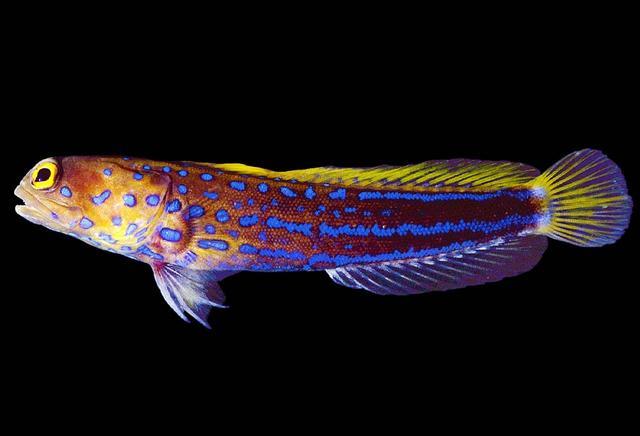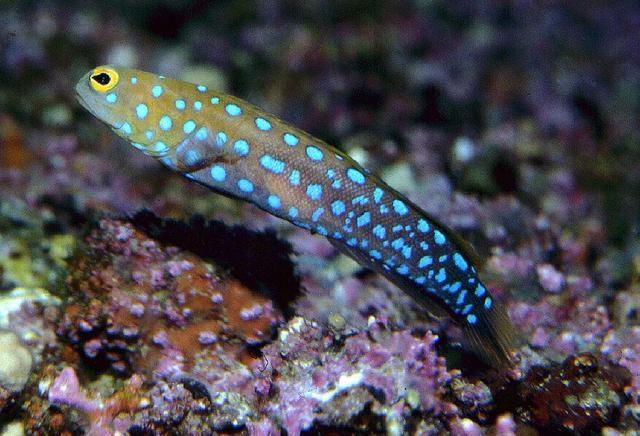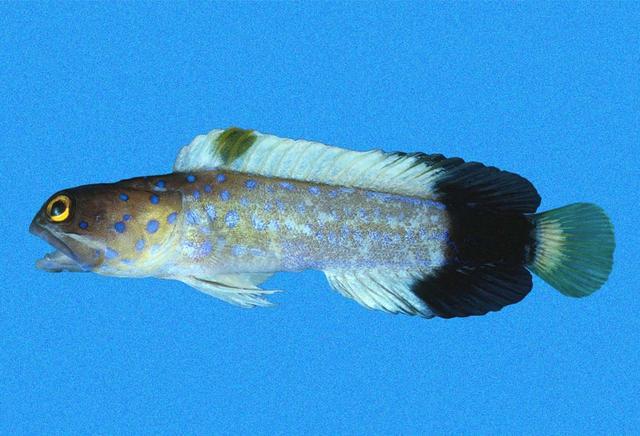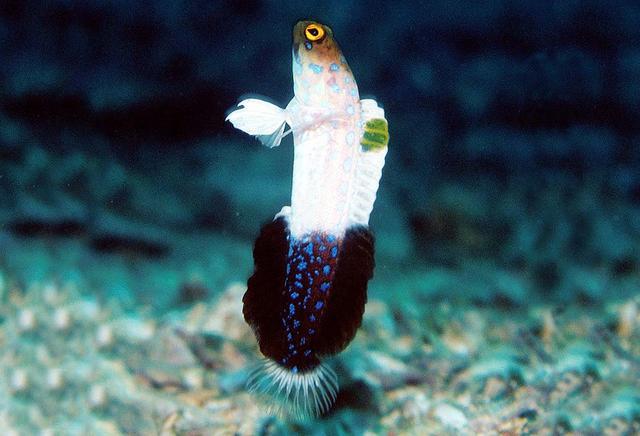Almost precisely a year ago I decided to give Blue Spot Jawfish (Opistognathus rosenblatti) another try.
I had a pair before but, unfortunately, they died in a tank crash in September 2017 while I was not at home. Those two I got from Live Aquaria and I assume I just got lucky that they turned out to be male and a female. I had those spawn once but it seemed that the male ate the eggs for some reason.
Getting pairs of Jawfish can be tricky as they are gonochoric and don't change sex once matured. And the majority of Jawfish doesn't have clear sexual dimorphism or dichromatism (the only exception I know of is O. randalli where the females have a black spot at the front of their hard dorsal fins. The males don't have this spot.)
With most Opistognathus species the males hold the eggs in their mouths during incubation and therefore have slightly larger heads. However, the males of the Blue Spot Jawfish do not hold the eggs in their mouths but rather take care of them inside a dedicated chamber of their burrows. Due to that difference in care for their offspring, males are in my experience smaller than females and have narrower heads and more slender bodies. Though this is rather hard to spot on the young individuals you generally find in stores.
According to Steve Robinson who collected them in Mexico, in the wild the Blue Spot Jawfish forms large colonies with hundreds of individuals on sandy planes. Usually, 4 to 5 females are situated around the burrows of the males. In the wild, they usually stay around 3 feet away from each other, and males are usually at least 6 feet from each other. However, in captivity, they will accept to be closer to each other as long as there is only one male in the group. Two males will fight to the death.
They are found at depths between 5 m and 25 m (16 to 82 feet), which puts them clearly above the thermocline. This means that the water temperatures they are found in resemble the surface temperatures:

Source: https://en.wikipedia.org/wiki/Gulf_of_California#Temperature
I kept my previous pair at room temperature in the living room (no heating in winter or AC in summer) and they were still active at 18 °C. However, when the temperatures dropped all the way to 16 °C in the winter they holed up inside their burrows and didn't come out for days.
On the other end of the scale, they handled peak temperatures of up to 31 °C for a few hours as long as it cooled down for the night.
These guys have a very wide temperature range and are best kept in a tank that follows a seasonal temperature pattern.
In early June of 2019, I picked 2 out of a number a local store had had for a while. I hoped I picked right but it soon turned out that I picked two females.
So a month later I bought another one but took care to do a better job of selecting a male. I just added the new one to the two females and right from the start, he acted differently so I was pretty confident that I had finally a male. But I had to wait almost 10 months before I got the ultimate confirmation when he stayed slim and started flashing while the other two got fatter and fatter.
And after a month of courtship, he finally spawned with one of the females
I definitely plan to do my best to capture and raise at least a few of the babies.
Here a few videos of them:
These were the two females 4 days after I got them:
The females 6 days after I got them:
End of April, beginning of May I noticed that something was going on and sure enough, I caught the male flashing (at 3:04) while one of the females (the one in the right "front" corner) started showing off her belly to signal she was interested (from 11:08 on):
At the time of this video he had been doing his dance for almost a week and the females still pretty much ignored him. But the female in the front was pretty gravid and sooner or later she had to mate with him:
Video from Friday night before the spawn - Both females were extremely agitated.
The females a day after the spawn. The male is watching the eggs in his burrow and didn't open it up all day. At the same time, both females decided to rebuild their burrows...
I had a pair before but, unfortunately, they died in a tank crash in September 2017 while I was not at home. Those two I got from Live Aquaria and I assume I just got lucky that they turned out to be male and a female. I had those spawn once but it seemed that the male ate the eggs for some reason.
Getting pairs of Jawfish can be tricky as they are gonochoric and don't change sex once matured. And the majority of Jawfish doesn't have clear sexual dimorphism or dichromatism (the only exception I know of is O. randalli where the females have a black spot at the front of their hard dorsal fins. The males don't have this spot.)
With most Opistognathus species the males hold the eggs in their mouths during incubation and therefore have slightly larger heads. However, the males of the Blue Spot Jawfish do not hold the eggs in their mouths but rather take care of them inside a dedicated chamber of their burrows. Due to that difference in care for their offspring, males are in my experience smaller than females and have narrower heads and more slender bodies. Though this is rather hard to spot on the young individuals you generally find in stores.
According to Steve Robinson who collected them in Mexico, in the wild the Blue Spot Jawfish forms large colonies with hundreds of individuals on sandy planes. Usually, 4 to 5 females are situated around the burrows of the males. In the wild, they usually stay around 3 feet away from each other, and males are usually at least 6 feet from each other. However, in captivity, they will accept to be closer to each other as long as there is only one male in the group. Two males will fight to the death.
They are found at depths between 5 m and 25 m (16 to 82 feet), which puts them clearly above the thermocline. This means that the water temperatures they are found in resemble the surface temperatures:
Source: https://en.wikipedia.org/wiki/Gulf_of_California#Temperature
I kept my previous pair at room temperature in the living room (no heating in winter or AC in summer) and they were still active at 18 °C. However, when the temperatures dropped all the way to 16 °C in the winter they holed up inside their burrows and didn't come out for days.
On the other end of the scale, they handled peak temperatures of up to 31 °C for a few hours as long as it cooled down for the night.
These guys have a very wide temperature range and are best kept in a tank that follows a seasonal temperature pattern.
In early June of 2019, I picked 2 out of a number a local store had had for a while. I hoped I picked right but it soon turned out that I picked two females.
So a month later I bought another one but took care to do a better job of selecting a male. I just added the new one to the two females and right from the start, he acted differently so I was pretty confident that I had finally a male. But I had to wait almost 10 months before I got the ultimate confirmation when he stayed slim and started flashing while the other two got fatter and fatter.
And after a month of courtship, he finally spawned with one of the females
I definitely plan to do my best to capture and raise at least a few of the babies.
Here a few videos of them:
These were the two females 4 days after I got them:
The females 6 days after I got them:
End of April, beginning of May I noticed that something was going on and sure enough, I caught the male flashing (at 3:04) while one of the females (the one in the right "front" corner) started showing off her belly to signal she was interested (from 11:08 on):
At the time of this video he had been doing his dance for almost a week and the females still pretty much ignored him. But the female in the front was pretty gravid and sooner or later she had to mate with him:
Video from Friday night before the spawn - Both females were extremely agitated.
The females a day after the spawn. The male is watching the eggs in his burrow and didn't open it up all day. At the same time, both females decided to rebuild their burrows...























